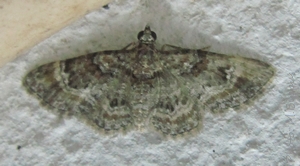
The double-striped pug is a moth of the family Geometridae. It is a widespread and common species, being found throughout the Palearctic region, including the Near East and North Africa.

Larentiinae is a subfamily of moths containing roughly 5,800 species that occur mostly in the temperate regions of the world. They are generally considered a subfamily of the geometer moth family (Geometridae) and are divided into a few large or good-sized tribes, and numerous very small or even monotypic ones which might not always be valid. Well-known members are the "pug moths" of the Eupitheciini and the "carpets", mainly of the Cidariini and Xanthorhoini. The subfamily was described by Philogène Auguste Joseph Duponchel in 1845.

Gymnoscelis, the pugs, is a large genus of moths in the family Geometridae described by Paul Mabille in 1868.

Eupitheciini is a tribe of geometer moths under subfamily Larentiinae, often referred to as pugs. The tribe was described by Tutt in 1896.

Calluga costalis is a moth of the family Geometridae. The species was first described by Frederic Moore in 1887. It is found in Sri Lanka, Taiwan, Borneo, Bali, Sulawesi, Seram, New Guinea and Queensland.
Gymnoscelis admixtaria is a moth in the family Geometridae. It was described by Francis Walker in 1862. It is found in Sri Lanka, India and Japan.
Gymnoscelis imparatalis, the flower-looper moth, is a moth in the family Geometridae. It is found from the Indo-Australian tropics of India, Sri Lanka, east to the Society Islands and the Marquesas Archipelago. The habitat consists of both lowland and montane ecosystems.
Gymnoscelis prouti is a moth in the family Geometridae. It is found on Borneo, Sumatra, Peninsular Malaysia and the north-eastern Himalayas. The habitat consists of upper montane areas.
Gymnoscelis pseudotibialis is a moth in the family Geometridae. It is found on Borneo, Peninsular Malaysia and in Singapore. The habitat consists of montane areas.
Gymnoscelis merochyta is a moth in the family Geometridae. It is found on Peninsular Malaysia and Borneo.
Gymnoscelis phoenicopus is a moth in the family Geometridae. It was described by Prout in 1958. It is found on Seram, Sulawesi and Borneo. The habitat consists of lower montane forests.

Gymnoscelis tristrigosa is a moth in the family Geometridae. It was described by Arthur Gardiner Butler in 1880. It is found from Sri Lanka and Taiwan to Fiji, Tonga and New Caledonia.
Gymnoscelis acutipennis is a moth in the family Geometridae. It was described by William Warren in 1902. It is endemic to Kenya.
Gymnoscelis deleta is a moth in the family Geometridae. It is found in India, Korea, Japan, Taiwan and probably in Sri Lanka according to Hampson.
Gymnoscelis ectochloros is a moth in the family Geometridae. It was described by George Hampson in 1891. It is found in India and Sri Lanka according to Hampson.
Gymnoscelis roseifascia is a moth in the family Geometridae. It is endemic to Sri Lanka.
Drapetodes fratercula is a moth in the family Drepanidae. It was described by Frederic Moore in 1887. It is found in Sri Lanka, north-eastern Himalaya, Borneo, Bali, and Sulawesi.
Avitta rufifrons is a moth of the family Noctuidae first described by Moore in 1887. It is found in the Indian subregion, Sri Lanka, New Guinea, and Queensland, Australia.
Hyposada postvittata is a moth of the family Noctuidae first described by Moore in 1887. It is found in Sri Lanka and Australia.





